#Buddha Victorious in Strife
Note
Can you please tell me what abilities sun wukong have because am always confused about it i even hear some people says that sun wukong is omniscient and omnipresent and can control time or that he is is a boundless character
At no point in JTTW is Monkey ever depicted as a boundless character with omniscience, omnipresence, and control over time. Anyone claiming that has never read the novel. Never ever trust any online claims about Sun Wukong unless a cited quote is provided.
Having said that, I am slowly compiling a comprehensive list of all of Monkey's magical abilities and skills, complete with corresponding Chinese terms and citations. However, I am nowhere close to being done (and won't be for years), so I can only give you a general list at this time. But I will link to my past articles where applicable.
The following is based on a list I wrote a few months ago for someone looking to make their D&D campaign more authentic.
Immortality - He has six layers of immortality. But these are more like layers of invulnerability. As a "bogus immortal" (yaoxian, 妖仙) he is still susceptible to injury and death because he hasn’t yet achieved Buddha-nature and broken free of the wheel of rebirth (see note #1 here for an explanation).
Invulnerability - He has an adamantine hide that can't be pierced or hurt by earthly or heavenly weapons and elements (this doesn't count the times that he allows himself to be cut). This is thanks to all of the immortal foodstuff he had eaten in heaven being refined within his body by his samadhi fire, giving him a "diamond body" (jingang zhi qu, 金鋼之軀). Sometimes he uses this invulnerability to freak out demons by blocking a sword strike with his bald head. However, he can still be hurt. For example, he is twice wounded by special elements born from spiritual cultivation, samadhi fire and wind (the book treats cultivated and heavenly elements as two different things). Also, one villain, a scorpion demoness energized with Buddhist dharma power, is able to successfully penetrate his skin by stinging him in the face with her tail.
72 changes - He can transform into anything. The only flaw is his tail, which doesn't always change the way he wants it to. Or, a character recognizes him because of his red butt.
Cloud somersault - This allows him to fly 108,000 li (33,554 mi / 54,000 km) in a single leap. The skill is actually a metaphor for instantaneous enlightenment, for those who achieve it will immediately arrive in the Buddha's paradise.
Magic hairs - He can change any one of his 84,000 hairs into anything he wants (tools, random objects, living creatures, etc.) These include hair clones, which are autonomous copies of himself that can range into the tens, hundreds, thousands, millions, or even billions. However, he only deploys these on a small scale in the novel. He never uses the power to its full stated extent.
Super strength - His greatest feat is carrying two mountains while running "with the speed of a meteor." But there are characters physically stronger than him. For instance, Monkey cannot escape the grip of the Great Peng bird once he is caught in his powerful talons.
Martial arts - He is proficient in armed and unarmed combat, being able to go toe-to-toe with deities with centuries more combat experience than him. "Short Fist," a historical style, is listed as his preferred boxing method. But he mainly relies on his magic iron staff for fighting.
General magic - Monkey is shown capable of calling forth gods and spirits, growing or shrinking to any size, parting fire and water, creating impassable barriers, conjuring wind storms, casting illusions, freezing people in place, putting anyone to sleep, unlocking any lock, bestowing superhuman strength, bringing the dead back to life, turning invisible, changing someone's appearance, traveling to and from heaven and hell, etc.
Magic Eyes - He can see through illusions. But this isn't always portrayed consistently, for I know of several times where Guanyin fools him, and even a god of the soil, a lesser deity, is once able to do the same thing.
Medicine - He can diagnose maladies and concoct medicines to solve the issue.
You can see that omniscience, omnipresence, and control over time are not listed. I think the problem is that people are confusing Sun Wukong at two different points in his character arc. The powers listed above come from the journey itself (ch. 13 to 100). The omni-level powers would come after he achieves Buddhahood at the end of the novel (ch. 100). However, it's very, very important to know that the story ends before Sun Wukong, now the "Victorious Fighting Buddha," performs any feats (i.e. he has no feats as a Buddha). I'm sure people could assign him powers ascribed to other Buddhas in religious literature, but what happens after the story ends is beyond canon.
I hope this helps.

#Sun Wukong#Monkey King#Journey to the West#JTTW#monkey buddha#Victorious Fighting Buddha#Buddha Victorious in Strife#magic powers#People who make spurious claims about Sun Wukong need to read the fucking novel!!!#Read the fucking novel!!!#Do it!!!#Just do it!!!#Lego Monkie Kid#LMK
150 notes
·
View notes
Text

Sun Wukong, the Monkey King: my design notes
[!! click here for the full line-up !!] [click here for just the goodies on tumblr]
also titled, "I underestimated my file sizes" TAT
Separate images and info below the read more, beware this is LONG <3
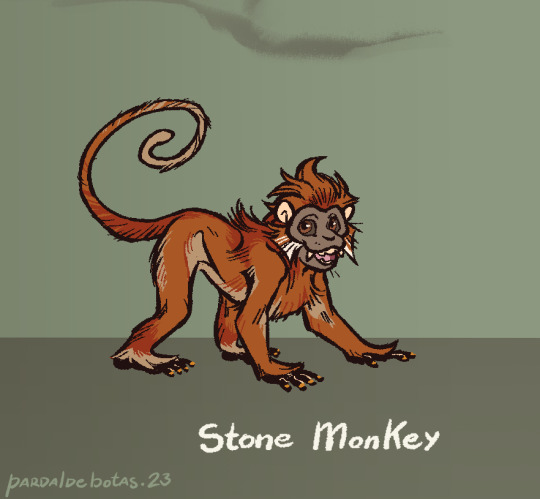
Stone Monkey: himbs baby, that is all <3 he's mostly based off the François Langur, but some of his anatomy and proportions lean more on the Gray Langur and Macaque side of things. His facial fur sort of forms a pentagon shape for the five elements, and I gave him ginger fur cus it's a common depiction for him but also baby langurs are very bright orange, and him not growing dark feels like an apt display of his more childish side, both good and bad. His nails are golden for a bit of a "hidden gem" from a stone egg. Also keeping the tail either in a spiral of C-curve when "engaged", and when droopy it has a feel of a heavy rope. Old World monkeys don't have prehensile tails, he can use it for balance and basic mobility but it's not a third hand for the sake of keeping his monkey-ness.

Handsome Monkey King: in one of the poems the monkeys are said to weave grass for mattresses, so I can see them coming up with a crown of woven grass and never-fading leaves and flowers for their king at the very least. His face skin is darker as an adult, but not much else changes overall. The fuzzy upper lips and sideburns are a feature of the species I'm basing him on and it felt like a good fit to add. I also love the forest langurs are so long-furred, makes for a good way to give him dimension but also, the linework style reminds me of old woodcut shorthands for fur. Added a jade coin for the symbolism, and it feels fitting that the king of such a miraculous mountain would have a treasure like that on him. Placcid chill eyes are imperative, dude's not had an existential crisis yet, he's straight up vibing.
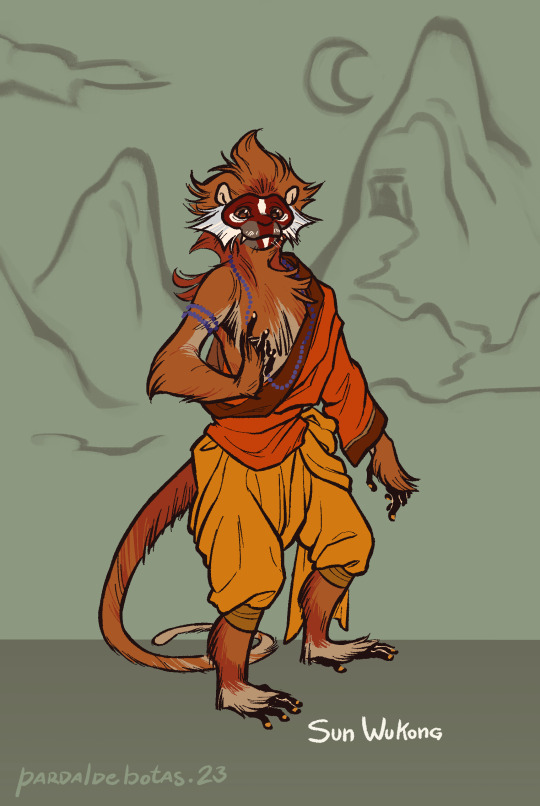
Sun Wukong: during his odd-ten years away from home, he learned human manners so he can stand but, I can see him still needing to lean on his tail to keep up his balance here and there. As he reaches the Western Continent (India) and learns the Way under Patriarch Subodhi, he adopts proper clothes for an apprentice and eventually becomes a Rishi. He dons his facial paint from then on, and after he masters the Way, there's a brightness in his pupils to show his cultivated immortality. The beads are purple solely to stand out over the deluge of oranges that is his design.
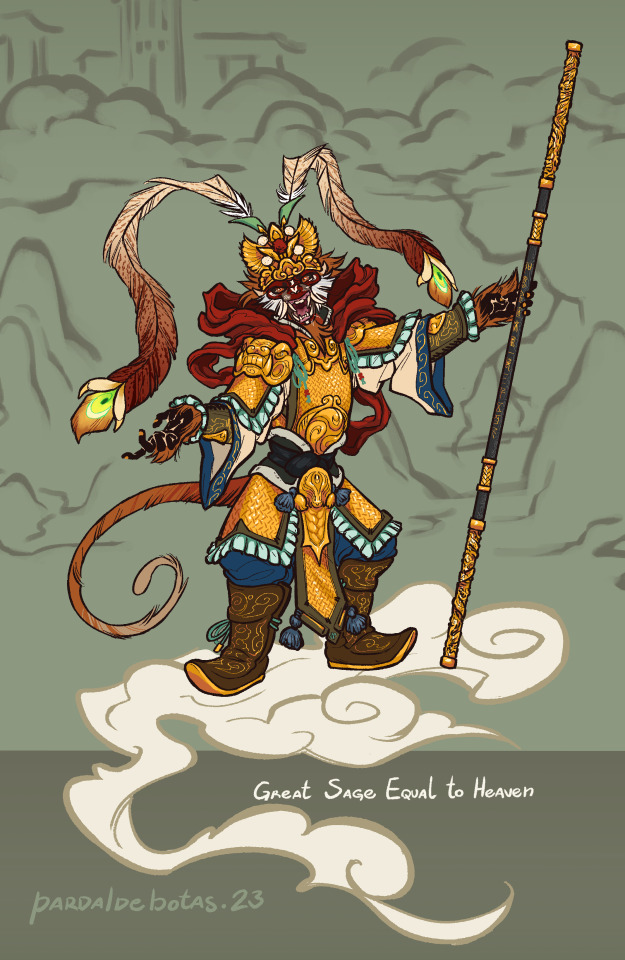
Great Sage Equal to Heaven: really went all out on this one orz this is Wukong at his most egotistical and ambitious, and I wanted his fit to truly embody that. Took bits from Peking Opera costumes and common depiction elements of him, with some bit of extra for appropriate levels of flair, like the phoenix feather design. I wanted to go for a mountain pattern mail but I couldn't figure out how to draw it, so I winged a pattern. I,,, doubt I'll ever draw this armor as detailed as here, but I wanted it to feel a bit overwhelming to look at, while also seeming like it doesn't quite fit him perfectly like it's swallowing him. Bit of a "baby wearing their parent's shoes" kind of vibe; he's stupidly powerful but he doesn't have what it takes to sit on the throne of Heaven. Also I leaned his expression to how he might appear during the Havoc in Heaven and then his bet with the Buddha. Full unbrindled rage murder monkey <3
-- Ruyi Jingu Bang: can't quite move on without my notes on the golden-hooped cudgel, now can I? The secondary hoops are there for further design appeal and for my own visualization of how the staff changes size (the hoops move over the staff's length as if to push it outward or inward). The metal is dark damascus alloy, though the pattern can be omitted for ease of drawing. One hoop end depicts a dragon, the other a phoenix, and in the middle of the staff is the canon inscription as described in the books, in seal script. Glow is optional and mostly for aesthetics.

Sun Pilgrim: out of his stolen armor, Wukong seems to swim in his robes but in a less overwhelming way. Went for the simple fillet headband cus his face is busy enough as it is. I know he's skilled enough to skin a tiger into pretty decent squares, but after one too many battles, anything would get tattered. He wears red, teal, black and yellow, four of the five cardinal colors, while white (the West) is still missing. His red and black half-robe doesn't fully cover the yellow underneath, a call back to his golden armor; he tries to use his wisdom and teachings to fight back the impulses of his past, but they still shine through at times. I kept only the leg bangs for dynamic elements to better show movement, but also one could say he's got.... golden hoops (haha get it, like his cudgel?? :oD)
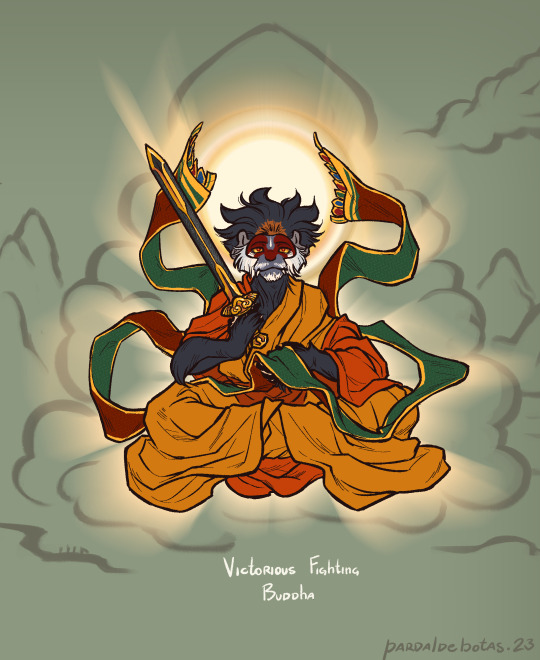
Victorious Fighting Buddha: leaned hard on the actual portrayals of the Buddha. Seeing that he's depicted with dark/blue skin, it felt appropriate to let the guy grow out of his baby ginger fur and into adult black, but a patch remains where the golden headband used to be. I didn't want to give him long hair so no bun, but instead, his fur has a sorta lotus-petals shape now rather than his single point. His face paint changes into a more domino-mask style, and his brow white line resembles a teardrop urna. I made the mail piece he holds longer to keep the flowy bits of his previous outfits, and I turned Ruyi Jingu Bang into the sword he wields.
Hello hi, this robbed me of three days of my life and I'd like to receive compensation x.x Anyway hope you enjoy this lad, I know I do! Also if you wanna send me asks about him pls feel welcome to, I'd love to chat about this bastard monkey (affectionate) (loving) (i`d die for him)
#jttw#journey to the west#xiyouji#jttw sun wukong#sun wukong#jttw fanart#monkey king#stone monkey#victorious fighting buddha#buddha victorious in strife#sun pilgrim#bell dragon art#expedition to the west au
278 notes
·
View notes
Text
Actually I’m not done thinking about how having the other five sages of Sun Wukong’s sworn brotherhood in Monkie Kid could introduce some really interesting dynamics and conflicts...like here’s five powerful yaoguai who knew the Monkey King as a calculating & ruthless party animal who won all the time, doesn’t care about humans, and who will do basically anything to keep his yaoguai family safe. But here he is now as a guy who has 0 subjects, 0 family members, now has a history of beating up yaoguai for the sake of humans, & who apparently exiled himself for 500 years after trapping his closest sworn brother (the Demon Bull King) under a mountain. And that’s to say nothing of lego show Sun Wukong being something of a mess who screws up a lot due to a chronic impulse of thinking he has to solve everything by himself without telling anyone anything because he thinks every bad thing is his fault.
Like imagine having an outgoing successful friend you deeply care for & then you all go through the trauma of warfare together but then he gets captured & disappears & when you see him next centuries later he’s this self-isolating sadsack who keeps failing at everything he tries & who hides his loneliness and guilt behind a carefree attitude but now you don’t know if you could even consider him a friend let alone a sworn brother any more on account of what happened to the Mt. Huaguoshan monkey yaoguai & that whole “beating up tons of yaoguai because a human told him to” thing.
Could lead to some interesting conflicts & discussions about morality and choices & questions about what makes a good life & a good person & what the right decision in this or that circumstance actually is...also might be interesting to see the other sages standing in near opposition to the pilgrims. Could be they think about the pilgrims, especially Tang Sanzang, like “You ruined a perfectly good yaoguai warlord is what you did. Look at him. He has depression.”
#monkie kid#monkie kid sun wukong#if SWK ended the journey as the Buddha Victorious in Strife that would be one thing#but as his lego show version seems to have ended the journey in loneliness and failure#he's not exactly a walking advertisement for Tripitaka's Guide To Happiness & Good Living
126 notes
·
View notes
Note
iwould like to hear your rant about lmk wukong's character assassination. In detail. if possible. please
(takes long drag of cigarette) it really did all start with the show itself coming out. see, after ROTTMNT came out, i don't think we could really expect flying bark to be "faithful" to its IPs and while whether that was a good thing for the TMNT franchise is absolutely something that can be discussed by people that aren't me, it's a whole lot more sensitive when you're handling a show based on a cultural treasure -
LEGO's line of toys dedicated to a sort of journey of the west spinoff is, in my opinion, an objectively good idea. other than boosting sales it feels kind of inevitable considering just how much LNY stuff they'd put out already, you know? to put it simply i don't have any problems with the lego monkie kid IP in concept, just with the way FB decided to run with its execution -- which ended up landing it squarely in "hot mess" territory.
basically - and i promise that this is relevant to wukong specifically, bear with me - i think that the first red flags were the fixation on their rendition of the six-eared macaque: a character that they've changed from being a single-use "evil twin" character that served the original Journey to the West's allegory for enlightenment (ie. that he was a manifestation of SWK's worst impulses) and then immediately fucking died when the situation called for it. he didn't show up for more than one storyline. they retcon a looooot of SWK's actual backstory as detailed by the book itself in order to make room for sadboy LEMH content so the writers could get their shipfix for him and SWK (which is annoying on more than one point, if you remember what I said about the evil twin thing. if you catch my drift. average flying bark moment)
but to put it simply i genuinely think they just made him... way too much of a lazy fucking self absorbed asshole? the beginning of the show has this which feels like a one-off gag but they double down on it later which makes they didn't write sun wukong -- this is after he's supposed to have ascended to victorious-in-strife buddha, mind you, and it ends up feeling less like sun wukong at any point in the storyline and more like... well, goku. from dragon ball super. which is its own, mostly unrelated can of worms in and of itself.
the thing is this is a character that's been used historically as an allegory, as representative of the people, objectively a cultural icon no matter where in china-influenced asia you find yourself (fantastic analysis of the problem with the way LMK pays homage to that allegory here), and also used in reference to, like, diaspora kids. this is a character that baaasically any chinese person with any kind of connection to the culture is going to see themselves in - especially in his reckless identity and subsequent ascension, you know?
and the main problem here is essentially that when you do this with a character that exsits as part of a media franchise... it's fine? it's whatever. people can just skip that. but when you are doing this as an attempt to adapt a piece of historically and culturally important literature - one that is made for children, one that is infinitely more accessible to diaspora children of that culture than any other adaptation that would be directed towards their age demographic, it feels like a punch in the gut. it's a level of disrespect that just really really hurts, all because the people in charge of it feel like they have to flanderize their characters for their fandom or they'll, like, die.
this isn't exactly organized nor is it every thought i have on the matter but basically tldr they forgot they were writing sun wukong and not their oc
93 notes
·
View notes
Note
Nezha: I woke up and chose VIOLENCE. I WILL COMMIT ARSON AND BURN EVERYTHING TO THE GROUND!!! I AM ANGRY-
Golden Cicada: Awwww, you’re so adorable! Give me a hug~
Nezha: Wh-What? nO, yOURE SUPPOSED TO BE SCARED OF ME! TREMBLE BEFORE MY WRATH-
Erlang Shen, recording: This is so cute.
The first adults aside from his mother and master, who aren't terrified of him and his powers, and he doesn't know how to deal with it.
*2000 years later ...*
The Buddha of Sandalwood Merit, Golden Cicada's 10th reincarnation: I have founded the "Hugs for Nezha" commitee. It has six members right now, including myself. *points at Taiyi Zhenren, Erlang Shen, the Buddha Victorious in Strife, Liu Chenxiang & Guan Yin*
Buddha of Sandalwood Merit: These guys can't agree on anything, other than that Nezha deserves all the hugs. I'm so proud of myself for bringing them together. :)
13 notes
·
View notes
Note
*At the end of the Journey*
Tripitaka now the Sandalwood Buddha: You are a true immortal as you always wished does it make you happy
Sun Wukong now the Buddha Victorious in Strife: People don't always know when they're happy, but I think so. And you?
Trip: I'm a little afraid to go home. I've been mortal and some part of me is mortal yet. I'm no longer like the other
(I was thinking about The Last Unicorn and Journey to the west sorry, do what you will with this)
...look.
Look.
I have a lot of thoughts about mortals, unprepared mortals, turning immortal. Tang Sazang is one of those mortals I think about a lot.
#Stars Answers#Tang Sanzang#Tripitaka#Sun Wukong#JttW#Journey to the West#LMK#Monkie Kid#LEGO Monkie Kid
56 notes
·
View notes
Text
Something something Sun Wukong started out being seen as dangerous, wild, and uncontrollable. Many people used to see him as a villain during his havoc in heaven, but in the end, he is ultimately deemed as a heroic figure, The Buddha Victorious in Strife. Erlang Shen already being revered as being a hero, the Illustrous Sage, by the masses. But in the end, he is deemed the villain for not showing mercy to his family in Lotus Lantern.
#good stuff good stuff#lotus lantern#journey to the west#erlang shen#sun wukong#jttw#relscreeches#brainworms r getting to me
116 notes
·
View notes
Note
Thinking about it, do any RL worshippers call Monkey King the Victorious Fighting Buddha?
Not really since there was already Victorious Fighting Buddha in Buddism. Rather he is worshipped by his title of Great Sage.
8 notes
·
View notes
Text

"Sun Wukong, Great Sage Equal to Heavens.
And the Buddha Victorious in Strife."
---------------
Art by me
PLEASE DON'T REPOST, COPY NOR TRACE MY ART !
ASK PERMISSION TO USE IT !
REBLOGS ARE HIGHLY APPRECIATED AND HELPFUL ! ^^
#the god of high school#god of highschool#goh#jin mori#sun wukong#갓오브하이스쿨#ゴッドオブハイスクール#진모리#ジンモリ#goh fanart#fanart#anime#digital art#myart
77 notes
·
View notes
Text
The Monkey King's Names and Titles
I've made a list of over 35 of Sun Wukong's various names and titles from Journey to the West (Xiyouji, 西遊記, 1592). It also covers common insults directed at him by assorted characters.
Obscure entries include:
His REAL name according to heaven
His rank within the hierarchy of cosmic immortals
His magic species
I'll update the list if more come to mind.
#Sun Wukong#Monkey King#Journey to the West#JTTW#Lego Monkie Kid#LMK#nicknames#titles#Victorious Fighting Buddha#Buddha Victorious in Strife#Great Sage#Great Sage Equaling Heaven
144 notes
·
View notes
Text
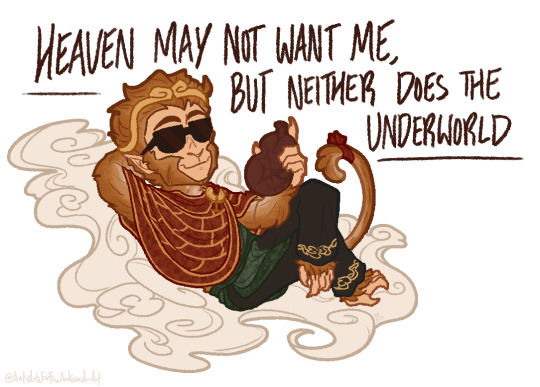

This was just supposed to be a doodle but I got carried away lol
[Image ID:
1. An image of Victorious-in-Strife Buddha Sun Wukong, reclining on his somersault cloud with shades and a calabash. Above him in all-caps reads "Heaven may not want me, but neither does the Underworld."
2. A screenshot of an anonymous Tumblr ask reading "unkillable by virtue of the underworld not even gonna BOTHER with the headache of tryna make him stay." End ID]
488 notes
·
View notes
Text
Hmmmmmm okay so usual disclaimer that I’m in no way shape or form an expert on Xiyouji or Journey to the West retellings but does it seem to anyone else that a lot of contemporary retellings of the westward journey place the monkey king in either an ambivalent or deeply unhappy position? Like of course you do have works such as Monkey King: Hero is Back and New Gods: Nezha Reborn where Sun Wukong clearly lost a lot but does still end the story with the hopes that things will get better, but then you have other works like Soi Chiang’s The Monkey King, Immortal Demon Slayer, and hell even Lego Monkie Kid where these Sun Wukongs basically lost everything & the narrative makes it difficult to see how anything could really improve for them...
#jttw retellings#sun wukong#monkey king#like genuinely are there any contemporary works#that actually end with him managing to restore Mt. Huaguoshan#and get to live with his friends and family#as the Buddha Victorious in Strife?
14 notes
·
View notes
Text

Understanding The Body Of Ares: The Art of Form, 4
What Does a "Warrior" Look Like?
_ _ _ _ _
Buddhist Monk Dipa Ma Barua abides by what she calls the "Warrior Principals" which are:
If you cannot walk, then crawl to your goal.
Do not let loss, sadness, fear, or anxiety deter you.
Focus your mind, and let meditation never leave you.
Be fierce, with all the love in your heart.
Never forget that everything is impermanent.
Let go of thinking. Your mind is all stories.
Remember your power. It is only beliefs that limit you.
Whenever you get a chance, be still inside.
Sit like a mountain.
There is no "problem". Only your thinking creates a problem.
Abide as thought-free awareness.
Practice now. Do not imagine there will be time later.
Go further.
Never give up the Dharma.
Even when you are dying, let your last breath be a bow to the Buddha.
Since the faces of our Warriors aren't always covered in armor.. I felt an intense urge to talk about War in the Spirit, What do our Warriors really look like?
whether you stand ready to assault the "enemy" or challenge your own beliefs, a Warrior is known by their stance. a true Warrior is never certain of their "rightness" or of their safety in their own beliefs - they know to engage at all is to be constantly aware.
if you think youve already won, i pray for and pity you, for the battle has only just started
when we move our attention to different types of "War" like War of E-Motion, War of Body, or in this case War of Spirit, the faces of our armor-clad imaginings take much different shapes. suddenly our best front-liners wear robes, or sit naked - and how does this change our battlefield?
you cannot assault Spirit. there is nothing to achieve. nothing to win. what we are at war with, then, are the forces of interference in our lives - what keeps us from Gods/Spirit
and when that is our battlefield (our beliefs, our ideas, our thoughts, our assumptions, our defense mechanisms), and our "enemy" (ourselves) uses every trick in the book - even our weapons change
Wars of Spirit are the hardest, because we dont expect to see "ourselves" on the other side, pushing against us. we spend a lot of time anticipating the problem being someone else, or the problem to be outside us entirely.. but the truth is, not only do we struggle, but we struggle against "ourselves" and the army of our own misconceptions and judgements about.. everything. our own Ego
it would be like declaring war in a mirror
know that while this battle isnt winnable, it is meant to start at Birth and end at Death. meaning that this battle is one of constant energy, and a constant awareness we need to do better by our own lives and the lives of others
in the mirrior of strife we learn ourselves, and with careful study, begin to understand that we fight our false selves in the same way you would wrestle a small child for the choke hazard in their hand. our stance should be in the understanding that we cannot let the destructive habits of Ego/False Self in
to be alive at all is to engage in this battle within yourself
and to navigate this battlefield, and encounter the traps and pitfalls of our own Spiritual Path - we realize the most liberating thing of all - we cant win
there is no one TO win
if you begin this conflict thinking "i must win against the forces of myself" you lose immediately, and will always lose
but when you realize this conflict is a dance with Gods, you will never fight a day in your life
so whether you are promised "Great Esteem" at the hands of the Gods, or lay waiting to be given what you are owed - i suggest you start figuring your way out of that trap as quickly as you can
the true dangers of taking on the awareness of this fight, is doing so in Righteousness. you cant fight the whole time thinking you are winning, and thats the joke
who is winning? why? why do you think you are victorious in any situation? why do you think winning can happen? what is this fight to you then, truly?
---
here i would like to say that the words of this entry were completely channeled, and i give my thanks, my praise, my love and my body to Ares for helping me understand the question i asked
as i move forward on my own journey i must answer this myself, and figure out what my stance is in my own life.. Gods i thank you! Mars i thank you!
#thebook#theartofform#ares#aresdeity#i am so happy to be sitting with another lesson here and again i thank Him for these powerful and challenging words..
5 notes
·
View notes
Text
A Sun to Banish the Darkness of Wrong Views
A Sun to Banish the Darkness of Wrong Views
by Jamyang Khyentse Chökyi Lodrö
You cut apart the web of conditioned existence,
And burn away the thicket of abundant faults,
Treasury of Wisdom, Adamantine Sharpness,[1]
At your feet I bow, and impart this message.
How pitiful it is that the clamour of hostility
Toward Dharma from someone holding wrong views,
Who is cloaked in the darkness of conditioned existence,
Should now be proliferating.
Clinging to one’s own view as paramount
Is a defilement, to be discarded through meditation;
Whereas possession of the authentic view
Naturally releases the knots of attachment and aversion
And frees from the constraining cage of conceptual elaboration.
The protector Nāgārjuna and his heirs explained
That all assertions of emptiness or non-emptiness
And the like are forms of conceptual construct.
Thus to judge Old and New teachings and adherents
As good or bad, and to praise one’s own side
While disparaging that of others
Is the tradition of ignoble people.
The gentle lord and second buddha,
Lobzang Drakpa ablaze in splendour,
Upheld the lineage tradition
Of the peerless Jowo [Atiśa] and his heirs.
He led a pure liberational life;
The Buddha’s Words arose for him as personal instructions;
And he understood how all teachings are mutually compatible.
Universal impartiality and benevolence
Is thus the tradition of this lineage.
Having entered this very tradition,
Then to act in a way that conflicts with it
Is to bring injury upon the teachings.
The fact that Padmākara of Oḍḍiyāna
And the divinely eminent Dīpaṃkāra
Belonged to one and the same wisdom-stream
Is clearly stated in the Book of Kadam.
And the great Lord Tsongkhapa’s guru
Lekyi Dorje,[2]
In his Great Aural Lineage Vajrapāṇi
And the Supreme Medicinal Nectar Replies,[3]
Agrees with the intent of Mahāmudrā and Dzogchen.
Paṇchen Lobzang Chökyi Gyaltsen,
Ngawang Lobzang Gyatso and others
Have practised profound Nyingma teachings.
Other great learned and accomplished masters too
Studied the Ancient Translations’ dharma-treasury
Of kama and terma and brought benefit to beings.
The Gendenpas have made treasure teachings,
Such as the Most Secret Wrathful Hayagrīva[4]
And the Kyergang pure vision Hayagrīva,[5]
The core of their tradition of secret practice.
For these reasons and on account of reliable histories,
Valid textual sources and multiple logical arguments,
One should never be hostile to the supreme Ancient Translations,
Either to its profound teachings or to its followers.
Nobody should object to a statement
Promoting the greatness of one’s own system.
But to feel deep hostility yourself
Or to introduce it in others
Is to enter a wrong path and discourage faith;
It is to incur a grave burden of wrong,
And to create a cause for evil destinies and the hells.
Thus, it is only wise to be cautious.
For most noble people[6]
It is befitting to accord with conduct of the noble,
And through the wonder of altruistic intention,
To bring benefit and happiness to the teachings and beings.
Sacred speech carved on stone,[7]
Tsa-tsas, prayer flags and wind-powered wheels—
To be touched by the same breeze that passes them
Will plant the seed of liberation.
Such virtuous practices are not be prevented.
The seven-day ceremonies based on the forty-nine day period
Clearly explained in the Medicine Sūtra, Purification Tantra and so on, [8]
As well as the life-story of the Oḍḍiyāna Guru,
The Chronicles of Padma,
The Guru’s secret Siddhi mantra,
The Peaceful and Wrathful deities and so on—
To suppress such practices and teachings
Would surely have damaging repercussions.
The same logic would render it inadmissible to recite
The name mantra invoking the wisdom mind
Of one’s own root guru,
Or to perform the visualization and recitation
For all the deities that originate in the maṇḍala of Guhyasamāja.
Take heed, therefore, with body, speech and mind.
For each town, monastery and patron
To perform recitation, offering and praise,
Each according to their own very system,
For as many ancient traditions as exist,
Is extremely virtuous and auspicious.
To follow the nonsense of Phabongkha,[9]
And cast aside tradition only to introduce
All manner of newfangled practices
Will only bring unhappiness to the world.
The teachings these days are in decline.
This is an age of strife based on degeneration.
What good, then, could there be in argument
Born of sectarian attachment and aversion? It is futile!
Remain, therefore, in the space of the middle way.
Through the virtue of this, may all living beings
Develop renunciation and bodhicitta in their minds.
May the wealth of their authentic view increase.
May they perfect the two accumulation, purify obscurations,
And swiftly attain the level of the two kāyas.
Thus, this was imparted by an inveterately idle, dharmaless wanderer who has developed faith in all the teachings of the victorious Buddha. May it be a source of immense benefit for the world. Sarva maṅgalam.
| Translated by Adam Pearcey with the kind assistance of Alak Zenkar Rinpoche and with the generous support of the Khyentse Foundation and Tertön Sogyal Trust, 2019.
5 notes
·
View notes
Text
The ambivalence continues: Tahomaru, Hyogo and Mutsu as a personification of Asura
In addition to the theory of Hyakkimaru representing Fudo, a fearsome Buddha from the episode 13 whose statue can be seen in the ravine where the horse was transformed into a kirin (which I posted earlier), let’s take a closer look at the Asura, the 12th demon who now possesses (as it appears) the Taho’s trio. It is actually interesting why the 12th demon is represented by Asura, quite an ambiguous demon who isn’t exactly a demon, if we google a little:

Ashura 阿修羅
Skt: Ashura, Asura
Beings just below humans in the Six States of Existence. Asuras are demigods, or semi-blessed beings. They are powerful, yet fierce and quarrelsome, and like humans, they are partly good and partly evil. In their earliest Hindu and Brahman manifestations, the Ashura are always fighting the Ten (Deva) for supremancy (often battling the deities commanded by Taishakuten, the Lord Indra of Hindu mythology).
The Aryans portrayed their own gods as benevolent heavenly beings, while the gods of the conquered people were demoted to serving as subjects of the Aryan deities. But the Asura King, one of the major gods of the conquered Dravidians, was a threat to the victors, and was subsequently demoted to demon status. The word asura was then sometimes translated as “non-god” or “anti-god” to complete the Aryan victory and to deny any chance of ranking the Asura among the heavenly gods. But with the emergence of Buddhism, Ashura is sometimes identified with sunshine and helping crops to grow. Many sources depict the Asura as demons, yet they are not always portrayed as sinister, and some are even godlike in their piousness.
In Japan, Ashura is often shown with three faces and six arms, with the side faces often expressing the violent warrior aspects associated with Ashura’s Hindu origin. With Ashura’s arrival to Japan in the 6th century from Korea and China, the deity is adopted as a guardian deity of Buddhism.
Really interesting. While it can’t be denied that Asura in the anime is indeed a demon, one of the 12, the fact that they chose the Asura and not just any other plain-monstrous creature as an embodiment of the 12th demon is extremely telling. It represents perfectly the ambivalent nature of Tahomaru’s aspirations: he is the guardian of the land, and at the same time, acting as such, he is in war with the gods (who side with Hyakkimaru as an innocent victim; or at least, they did at first).
This dual nature of the asura is also reflected in Buddhism, where on the one hand they are counted among the eight classes of beings who protect Buddhism (Hachibushuu, this page) while on the other hand their realm (said to be located on the ocean floor) is considered to be a world of strife and represents one of the six realms of transmigratory existence (rokudou-e). In Japan they usually are found in sets of the Hachibushuu, the eight kinds of guardian spirits of the Dharma (Buddhist law), when they are represented with three faces and six arms.
Source:
https://www.onmarkproductions.com/html/hachi-bushu.shtml#ashura
5 notes
·
View notes
Text
Character: The Monkey King
The first seven chapters of the Journey to the West tells the story of the Monkey King, which is my favorite character of the entire novel. The monkey is born on the Flower Fruit Mountain from a stone, and learns Taoist way from Patriarch Bodhi in the Three Stars and Slanting Moon Cave (“斜月三星” 洞). In Chinese, the character “heart” (“心”) could be seen as a combination of three stars and a slanting moon (斜月:一勾;三星:三点). The Surangama Sutra also believes that human’s heart has 72 phases while Sun Wukong knows 72 transformations; the character of Sun can therefore be viewed as a representation of the human heart, which can be unruly sometimes. At the beginning of the novel, Sun is a fighter who could be vicious and ill-tempered; he creates chaos with his restless irreverence and irrepressible curiosity. The first part of the novel ends with Buddha changed his five fingers into the five elements (metal, wood, water, fire, and earth), symbolizing the “greed, jealousy, ignorance, slowness, and doubt” in Buddhism, to trap the Monkey King.
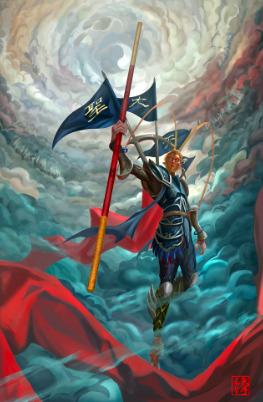
Accompanying Xuanzang on a journey to the West truly redeems the Monkey King. Together with Pigsy and Sandy, the group encounter all manner of danger, including monsters, evil magicians, mountains of fire, and evil spirits. Sun’s wit helps Xuanzang escape many perilous situation. At the end of the journey, all of the travelers are spiritually rewarded; Sun achieves the status of “Buddha Victorious in Strife.”, the highest state of enlightenment in Buddhism.
Even today, so many songs and movies come out every year with the Monkey King as a theme; I believe that’s because we can all find a version of ourselves in this character, as he is the representation of the human hearts --- brave but need the spiritual journey to be completed.
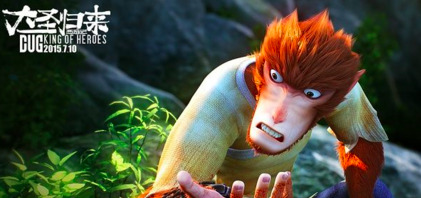
39 notes
·
View notes